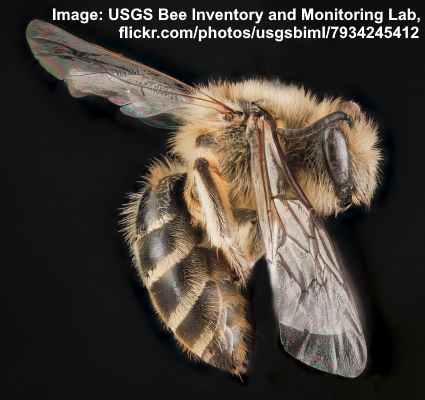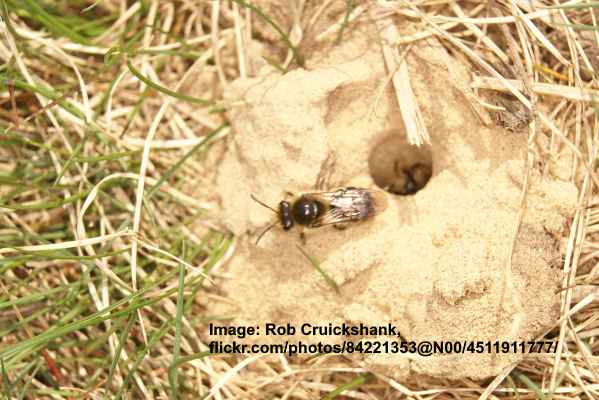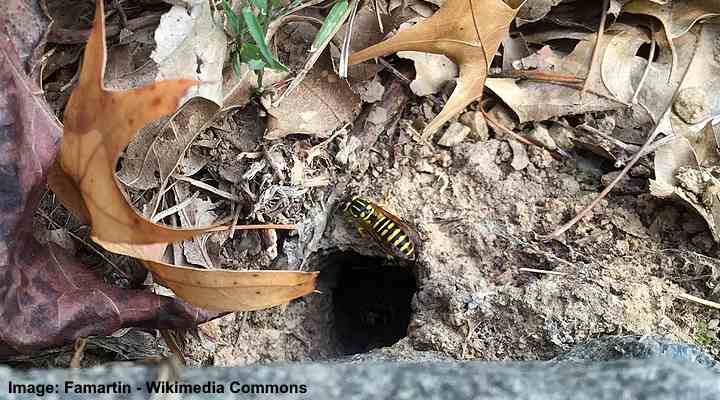Types of Ground Bees (With Pictures) – Identification and Control

Ground bees or ground nesting bees are solitary bees that make nests in the ground. Ground bees tunnel into dry soil to create underground nests about 6” (15 cm) long where they raise their young. Despite these solitary bees being beneficial to the ecosystem and biodiversity, many gardeners view ground bees as pests. Ground nesting bees can create dirt piles in lawns, spoiling the look of lush turfgrass. Also, many people may be concerned that ground bees can sting.
Ground bees may look like yellow jackets or wasps, but they are not as aggressive. Ground bees are remarkably similar to honeybees, however they don’t produce honey. A ground bee is typically tan and black and has the habit of creating a nesting burrow in the ground.
This article is a guide to identifying bees that burrow in the ground. You will learn about the activities and behavior of ground bees. However, suppose ground bees are a nuisance in your yard. In that case, you will get helpful tips on controlling ground bees without using chemicals.
How to Identify Ground Bees

Ground bee (Colletes inaequalis)
The most common species of ground bee — Colletes inaequalis — is a black and tan-colored bee with a black abdomen and tan stripes. These ground nesting bees can be identified by their fuzzy tan-colored head, pair of translucent wings, heart-shaped face, large compound eyes, and two segmented antennae. Ground bees are the shape of honeybees.
Ground bees typically measure 0.5” (13 mm) long and are active between March and July. Although the ground-nesting bees are black or brown, some species can have metallic green, blue, copper, and red colors.
How to Identify Ground Bees Nest

Ground bee’s nest
The nest of a ground bee looks like small mounds of dry earth or sand with a hole in the center. Each ground bee nest may only be a few inches (5 – 8 cm) wide and an inch or two (2.5 – 5 cm) tall. The characteristic hole in the center is about the diameter of a large pencil.
An identifying feature of a ground bee’s nest is that they tend to be in groups. Although ground bees are solitary, with only one female to a nest, you may find several of these small mounds close to each other. Ground bee nests are usually located on sparsely vegetated ground, bare patches of lawn, or near paths.
Another feature of ground bees is that they like to warm themselves in the sun. So, you will often find ground bee nests in sunny areas of your garden or on south- or east-facing slopes. The females often sit at the mouth of the nest, sunning themselves.
Ground Nesting Bees
Ground nesting bees get their name from their habit of burrowing nesting channels in the soil. Unlike honey bees that live in large colonies and hives, ground bees live a solitary life. They are usually active from the first warm day of spring, and they buzz from flower to flower, feeding on nectar and pollinating flowers.
What Types of Bees Burrow in the Ground?
The species of ground-nesting bees include mason bees, sweat bees, leafcutter bees, digger bees, and mining bees. It’s a fact that 70 percent of more than the 20,000 species of bees burrow in the ground.
Due to their activity and behavior, ground bees are also called cellophane bees or polyester bees. They get this common name because they use their forked tongue to coat their underground burrows with a plastic-like substance to keep the tunnels dry.
What Attracts Ground Bees to Yards?
Ground bees are attracted to gardens that have the right type of soil and attractive, fragrant flowers. The ideal soil conditions that attract ground-nesting bees are dry soils or bare patches of ground on turfgrass. In addition, if there are tunnels left by rodents, then ground bees may take up residence there.
Ground bees can benefit your garden; therefore, many gardeners like to attract these spring pollinators. You can plant flowering shrubs like daisies, lavender, zinnias, borage, and goldenrod to attract ground bees. The added advantage of these flowers is that they are said to help deter other bugs like fleas, mosquitos, and moths.
Identifying Ground Bees vs. Yellow Jackets

Yellow jacket at the entrance to a ground nest
There are a few differences between ground bees and yellow jackets. Ground bees tend to have furry bodies, whereas yellow jackets have smooth black and yellow striped bodies. Yellow jackets will sting unprovoked, but a ground bee will tend to ignore you.
One of the reasons it can be easy to confuse yellow jackets and ground bees is that both species build nests underground. Also, neither ground bees nor do yellow jackets produce honey.
Generally, yellow jackets can be a severe nuisance in gardens because they can sting multiple times, attack without provocation, and be very territorial. Also, because yellow jackets have smooth bodies, they don’t pollinate flowers the way ground bees do.
Do Ground Bees Sting?
Although ground bees can sting, they will rarely sting you. Ground bees typically only sting humans when provoked. Therefore, if you disturb their nest or try to handle the bees, you may end up with a bee sting. Generally, ground bees are docile, non-aggressive insects.
Like most species of male bees, male ground bees don’t have stingers and, therefore, can’t sting or bite you.
A danger of ground bee stings — like any sting from a bee — is suffering from an allergic reaction. Therefore, if you notice any adverse reaction after a bee sting, like throat or tongue swelling or a rapid pulse, you should seek medical attention immediately.
Are Ground Bees Aggressive?
You typically have nothing to fear from ground bees because they are docile creatures. Females are not territorial and don’t defend their nesting sites. On the other hand, male ground bees tend to be more active and can appear aggressive. However, because they can’t sting, they can’t do any harm.
Do Ground Nesting Bees Produce Honey?
Ground-nesting bees are not honey producers. Although ground bees feed on nectar from flowers and look like honeybees, they only use nectar to provide for themselves and their young. In fact, most bees don’t produce honey. The bee species that makes honey are bees in the genus Apis.
Advantages of Ground Bees in Your Yard
There are many benefits of attracting ground bees to your yard. First, the bees tend to be active in early spring and summer. Therefore, any seeming disadvantage to the bees is only short-lived.
Here are a few benefits of having ground bees in your garden.
Ground bees are beneficial pollinators
The most significant benefit of ground bees is that they pollinate flowers. Because the bees are active early in the season, they are vital pollinators for spring flowers. This positive activity boosts your garden’s ecosystem and ensures healthy crop plants and wildflowers.
Ground bees can improve the health of soil and lawns
Ground bees burrow in the soil to create nesting sites. This activity can help aerate lawns and soil and improve the penetration of nutrients and water. Allowing ground bees to nest in your garden can result in improved soil and lawn health. Any aesthetic damage usually disappears when the bees abandon the nests in late spring.
Ground bees are not aggressive
Usually, attracting ground bees to your garden doesn’t pose any risk. Unlike aggressive wasps and hornets, ground bees will usually leave you alone. What’s more, you help encourage biodiversity in your yard and the surrounding neighborhood.
Disadvantages of Ground Bees in Your Yard
Not everyone welcomes the appearance of ground bees in their yard. Sometimes, homeowners may mistake them for a yellow jacket or another aggressive flying bug. In other cases, ground bees can impact a garden’s aesthetics.
For example, the most common complaint of ground bees is that they leave piles of dirt on lawns, ruining their appearance. In some cases, the number of holes and dirt mounds may give the impression of a large bee colony. Therefore, you may want to get rid of ground bees from lawns.
However, it’s good to remember that ground bees typically affect sparse lawns. So if you want to keep the bees away, it is best to improve your lawn’s health with proper watering, lawn fertilization, and reseeding. This way, ground bees will find other nesting locations in flower beds or other areas with bare soil.
Should You Kill Ground Bees?
There is generally no need to eliminate ground bees from your yard. The burrowing bees don’t pose a threat to humans and provide a beneficial service. In addition, the docile bees are important spring pollinators and promote a healthy and balanced ecosystem.
There is another reason why killing ground bees is not a great idea. According to a 2021 study by the University of Cambridge, the loss of pollinators poses a threat to ecosystem services. For example, around 75 percent of crops depend on pollination from bees, wasps, butterflies, and beetles.
How to Get Rid of Ground Nesting Bees
Suppose you have a problem with ground-nesting bees, what can you do to deter the bees from nesting in your lawn or the ground among your shrubs? There are a few natural deterrents and control methods to get rid of ground-nesting bees without harming the environment.
When trying to eradicate bees nesting in the ground, it’s best to avoid using chemicals or pesticides. Spraying insecticides to control bugs can harm beneficial insects and humans. Additionally, pests in the garden can build up resistance to pesticides, making them ineffective in the long run.
Cover nesting holes to get rid of ground bees
The best way to get rid of ground bees from your garden is to block the entrance to the nest. Try to do this early in the season and ensure there is no bee in the nest. Then, all you need to do is fill the burrow with soil and put a stone over the entrance. This will prevent the female from laying eggs and raising her young.
A DIY spray to eliminate ground bees
Make a homemade, non-toxic bee repellent to help get rid of ground bees for good. It’s said that bees don’t like the aroma of peppermint. Also, cayenne pepper and cinnamon can help act as a natural repellent.
To make a ground bee repellent, first, fill a 17 oz. (500 ml.) spray bottle three-quarters full and add 3 teaspoons of liquid Castile soap. Then add a few drops of peppermint oil, 1/8 teaspoon of cayenne pepper, and 1/8 teaspoon of cinnamon. Shake thoroughly to combine the ingredients.
Next, spray the bee repellent solution liberally around the entrance holes to the ground bee nests. Alternatively, you can pour the liquid into the nests to force the bees to set up home somewhere else.
Water grass to get rid of ground bees from lawns
Ground bees are attracted to dry soil and often create burrows in dry, bare patches of lawn. They even have the ability to line their nesting burrows with a cellophane-like lining to keep the nest dry.
The best way to drive ground bees away from your lawn is to water it thoroughly and keep the turfgrass moist. Once the ground bees have vacated their burrows, you can mulch the nesting areas or fill the holes with soil and grass seeds to repair bare patches.
Homemade vinegar spray to deter ground bees
Some people say that vinegar can help get rid of ground bees. If you want to try this method, make a vinegar spray by combining equal parts of vinegar and water in a spray bottle. Then, spray the acidic liquid in the nesting hole and around the site. This should hopefully deter the bee from returning.
It’s good to remember that vinegar can kill plant roots and turfgrass. Therefore, you should only use this method where there is no useful vegetation growing.
Related reading: How to use vinegar as a natural weed killer.
Sprinkle cinnamon around the nest as a ground bee deterrent
It is possible that cinnamon can act as a natural repellent powder for bees. It is claimed that the aroma of cinnamon is off-putting to various species of bees. The idea is that sprinkling liberal amounts of cinnamon powder around the nest everyday forces the bees away without harming them.
DIY ground bee trap
One way to get rid of annoying flying pests in your yard, including ground bees, is to make a sugary water trap. This type of trap helps eliminate bees and wasps because the sugar attracts them and then prevents them from flying away. The bees then drown in the liquid.
To make a homemade ground bee trap to kill them for good, you’ll need a plastic soda bottle and sugar water. Half-fill a plastic soda bottle with warm water and add 1/4 cup of sugar. Shake well until the sugar dissolves. Then, cut the top off a plastic soda bottle, turn the top upside down and place it in the bottle to create a funnel. Set the trap near your ground bee nests.
However, this bee trap affects everyone because it kills bees and reduces the number of pollinators.
Plants that deter ground bees
If you are trying to get rid of ground bees from your yard, you could also try planting shrubs and flowers that repel bees. It’s possible that by using bee-repelling plants in combination with other control methods, you could reduce the number of nesting ground bees in your garden.
Although there is no scientific evidence, some gardeners report success in getting rid of ground bees by planting the following plants and crops:
- Cucumbers
- Basil
- Wormwood
- Red geraniums
- Mint
- Marigolds
Even if the plants don’t work, you will have more diversity in your garden and have some vegetables or herbs to enjoy in a summer salad. Additionally, flowering geranium and marigolds can add plenty of color to your garden.
Learn how to identify different types of bees.
Related articles:
